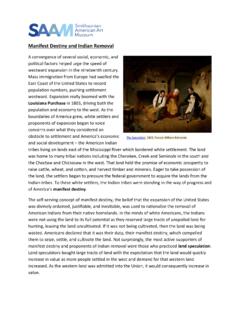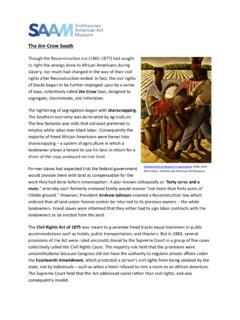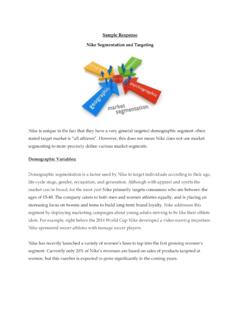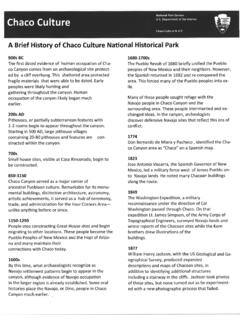Transcription of History and Evolution of Public Education in the US
1 History and Evolution of Public Education in the US. Throughout the History of Public Education in the US, Public schools have filled multiple roles. These roles are an outgrowth of why Public schools came into being and how they have evolved. This publication briefly reviews that History . For a look at how these historical purposes shape Education today, see CEP's 2020 publication, For the Common Good: Recommitting to Public Education in a Time of Crisis, available at Before Public Schools In the early years of the nation, schooling was haphazard. Many children were excluded on the basis of income, race or ethnicity, gender, geographic location, and other reasons.
2 The children who did receive instruction, primarily white children, were educated through a hodgepodge of arrangements: Church-supported schools Local schools organized by towns or groups of parents Tuition schools set up by traveling schoolmasters Charity schools for poor children run by churches or benevolent societies Boarding schools for children of the well-to-do Dame schools run by women in their homes Private tutoring or home schooling Work apprenticeships with some rudimentary instruction in reading, writing, and arithmetic Early schools were financed from various sources and often charged tuition.
3 Without a formal system for funding Education , local schools were dependent on parents' tuition payments, charitable contributions, property taxes, fuel contributions, and in some cases state support. At the time of the american Revolution, some cities and towns in the Northeast had free local schools paid for by all town residents, but this was not the norm. (A few Northeastern cities also had free schools for African american children.). Center on Education Policy 2. Children in the South were educated mostly in tuition-charging or parent-organized schools. Some rural areas had no schools.
4 The schools that did exist outside of cities were often hard to get to, skimpily equipped, and overcrowded. Teachers were poorly paid, transient, and inexperienced, and some were undereducated themselves. In no state was Education compulsory or fully supported by taxes. Democracy and the Origins of Public Schools Preparing people for democratic citizenship was a major reason for the creation of Public schools. The Founding Fathers maintained that the success of the fragile american democracy would depend on the competency of its citizens. They believed strongly that preserving democracy would require an educated population that could understand political and social issues and would participate in civic life, vote wisely, protect their rights and freedoms, and resist tyrants and demagogues.
5 Character and virtue were also considered essential to good citizenship, and Education was seen as a means to provide moral instruction and build character. While voters were limited to white males, many leaders of the early nation also supported educating girls on the grounds that mothers were responsible for educating their own children, were partners on family farms, and set a tone for the virtues of the nation. The nations' founders recognized that educating people for citizenship would be difficult to accomplish without a more systematic approach to schooling. Soon after the american Revolution, Thomas Jefferson, John Adams, and other early leaders proposed the creation of a more formal and unified system of publicly funded schools.
6 While some Northeastern communities had already established publicly funded or free schools by the late 1780s, the concept of free Public Education did not begin to take hold on a wider scale until the 1830s. The new federal government provided encouragement and support for establishing Public schools. Although the main responsibility for schooling rested with states and localities, federal ordinances passed in 1785 and 1787 gave substantial acreage of federal lands in trust to new states entering the union, as long as the states agreed to set aside a portion of these lands for the support of Public schools.
7 1 These federal land grants not only supported the creation and maintenance of schools in each of the townships carved out of former territories, but also helped to build stable communities across the country, each with a local government and Education system. The land grants show the value placed on Education as positive element of nation- building by the first federal leaders. 1 At the time of these Ordinances, most of the territory west of the Mississippi was federally owned. Center on Education Policy 3. The Establishment of Common Schools . The common school movement encouraged the creation of Public schools for multiple purposes.
8 In the 1830s, Horace Mann, a Massachusetts legislator and secretary of that state's board of Education , began to advocate for the creation of Public schools that would be universally available to all children, free of charge, and funded by the state. Mann and other proponents of common schools emphasized that a Public investment in Education would benefit the whole nation by transforming children into literate, moral, and productive citizens. Common school advocates emphasized the knowledge, civic, and economic benefits of Public schooling. Common schools would teach the three R's (reading, writing, arithmetic), along with other subjects such as History , geography, grammar, and rhetoric.
9 A strong dose of moral instruction would also be provided to instill civic virtues. Educating children of the poor and middle classes would prepare them to obtain good jobs, proponents argued, and thereby strengthen the nation's economic position. In addition to preparing students for citizenship and work, Education was seen by some reformers as a means for people to achieve happiness and fulfillment. Common schools were also proposed as a way to promote cohesion across social classes and improve social outcomes. Reformers argued that common schools would not truly serve as a unifying force if private schools drew off substantial numbers of students, resources, and parental support from the most advantaged groups.
10 In order to succeed, a system of common schooling would have to enroll sufficient numbers of children from all social classes, including the most affluent and well- educated families. This idea met with resistance from many Americans who did not want to pay to educate other people's children. And some passionate advocates of common schools did not interpret a universal system of Public Education as being equally available to children of all races and ethnicities. Advocates saw universal Education as a means to eliminate poverty, crime, and other social problems. Some early leaders argued that the costs of properly educating children in Public schools would be far less than the expenses of punishing and jailing criminals and coping with problems stemming from poverty.














